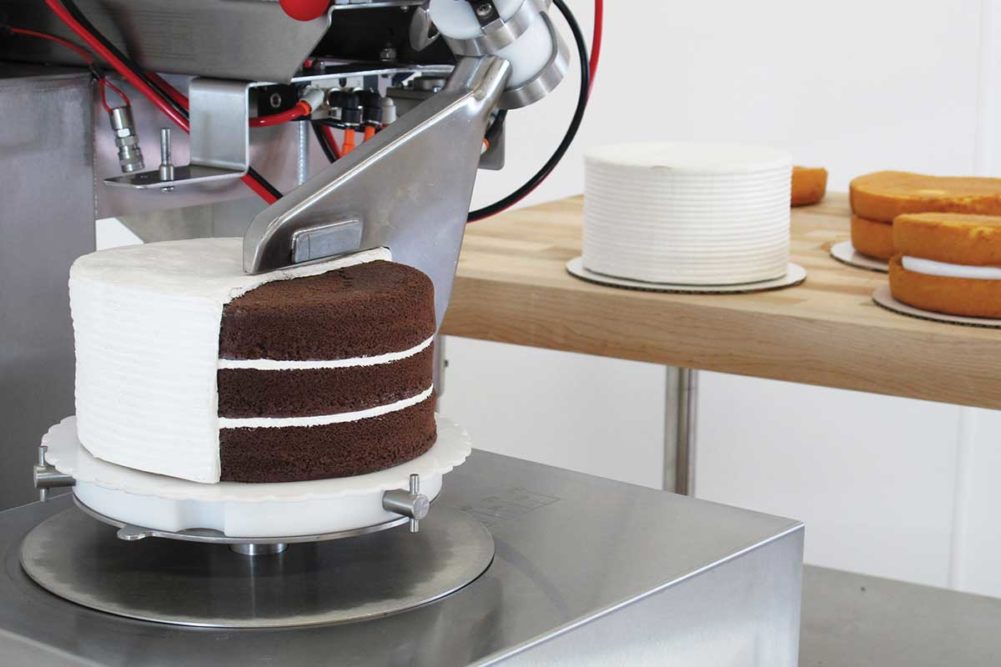Cutting and depanning cakes and cheesecakes can be a messy business, but there are different methods depending on what each baker is trying to achieve.
“One of the lines we always tell our customers is ‘temperature, temperature, temperature,’ ” said Sergio Caballero, regional sales manager, FoodTools. “It’s really the key to cutting it correctly.”
Generally, all cakes are frozen when they’re cut. Some are frozen to just under 32˚F while others are colder.
“Most bakeries have products coming out of the freezer at zero,” Caballero said. “That’s a deep freeze. That way the core is cold.”
The ideal temperature to cut a cake is dependent on the product as well as the tool that’s doing the cutting.
“Some of it comes down to the cutting technology, whether it’s a mechanical cut or an ultrasonic cut will also vary on the temperature,” he said. “For instance, with mechanical, we want it to have more of a deep freeze depending on the product. If we’re using an ultrasonic cut, your dwell time in the freezer is going to be half the time. Now you’re cutting frozen versus a deep freeze cut.”
Caballero said he works with the customer to decide whether to use a mechanical blade or an ultrasonic slicer, which depends on the product and its temperature.
The freezer dwell time is important because the longer a cake must be placed in the freezer before cutting, the higher the freezer costs. While an ultrasonic cutter costs more, it can save in freezer costs as those cakes don’t require a deep freeze.
Caballero said cutting specialty cakes works much the same way as others, although sugar-free cakes and cheesecakes can be more difficult as there’s not as much fat in them, making them denser and more brittle. Bakers just need to identify the right temperature for the product.
AMF offers a number of gentle depanning methods, including the Den Boer Overturning Depanner which is best suited for cake or snack products.
“Products are gently extracted from the pan by turning the products upside down (single configuration) or right side up (double configuration),” said Hans Besems, executive product manager, AMF Tromp, an AMF Bakery Systems brand. “In smaller cakes, AMF uses a Den Boer Needle Depanner which utilizes very fine needles to pick products so after depanning there are no markings on products and products are protected during removal from the pan.”
Bakeries making cakes and muffins are looking for ways to reduce labor and improve efficiency in their facilities, and equipment manufacturers are eager to help.
“It’s no secret that the baking industry is really struggling to find people at all skill levels,” said Jamie Bobyk, marketing manager, Apex Motion Control. “With the combination of the skilled laborers retiring and no one to replace them because industrial manufacturing is not appealing to the general public, the gap is getting bigger and bigger to fill.”
Advances include integrated vision systems and advanced control systems, said Sonia Bal, director of marketing, Unifiller.
“Manufacturers are incorporating sophisticated control systems into depositors, utilizing sensors, cameras and software algorithms to enhance accuracy,” she said. “These systems provide real-time feedback, enabling precise depositing of delicate inclusions.”
She mentioned the Unifiller+ App, which empowers frontline operators to troubleshoot problems and train and share knowledge while optimizing performance.
“Vision systems are being integrated into depositing technology to ensure accurate placement of delicate inclusions,” Bal added. “These systems can detect variations in product shape, size or position, enabling adjustments in real-time for optimal accuracy.”
Bobyk mentioned the versatility of the Baker-Bot, a cobot that can be integrated into a variety of lines. It uses pressurized tanks to feed the end effector, or attachment, at the end of the robotic arm.
“Instead of having a stationary depositor that deposits batter or icing directly onto a product as it moves down the conveyor, the Baker-Bot uses 3D vision, allowing it to target deposit quickly and accurately anywhere on the conveyor,” he said.
It works when applying frosting or icing as well, adjusting on the fly to apply it consistently regardless of peaks and valleys in the cake, “resulting in a much better looking and more consistent application of icing, which translates to less touch up and reduced ingredient costs,” Bobyk added.
The newer equipment that makes up cake production lines today are more reliable than in the past, said Bob Peck, vice president in charge of engineering, E.T. Oakes Corp.
“Servo motors are in place of cams and gears, so we’re able to do things with less maintenance and more reliability,” he said.
Chuck Sena, director of sales, Axis Automation, said it’s important to take a multi-pronged approach to tackling industry problems.
“Matching the proper deposit tooling to the production requirements is a key to get the highest yields and maximum line efficiency,” he said. “From there, we are also incorporating vertical and horizontal motion into our depositing process. Having servo control of the height and travel of the depositor tooling during each cycle gives us the ability to maintain tight control over the product — ensuring consistency over the full production run.”
Benjamin Jewell, sales manager, US Midwest, Bühler, said Bühler’s design philosophy is to simplify machinery to minimize the need for tools, time and people.
“We try to minimize the tools and time required to make a change or the amount of people who have to integrate into a system,” he said. “You want to keep the number of people with their hands in the cookie jar per se, out.”
Bakers working to increase throughput and efficiency while reducing their dependence on labor have many tools at their disposal. Figuring out the best solutions for their own plants will help them reach their goals and keep their lines running smoothly.
This article is an excerpt from the December 2023 issue of Baking & Snack. To read the entire feature on Cake Processing, click here.




